If you’ve ever opened your dishwasher to find plastic cups still sweating like they just ran a marathon, I feel your pain. I test appliances for a living, and I’ve stood in a lot of damp kitchens. So here’s the short, expert answer to what is Bosch Crystal Dry: it’s Bosch’s zeolite-powered drying system that turns humidity into heat to dry even stubborn plastics, fast and efficiently. It’s clever chemistry packed into premium dishwashers, and yes, it actually works. Stick with me and I’ll show you how, why, and when it shines.
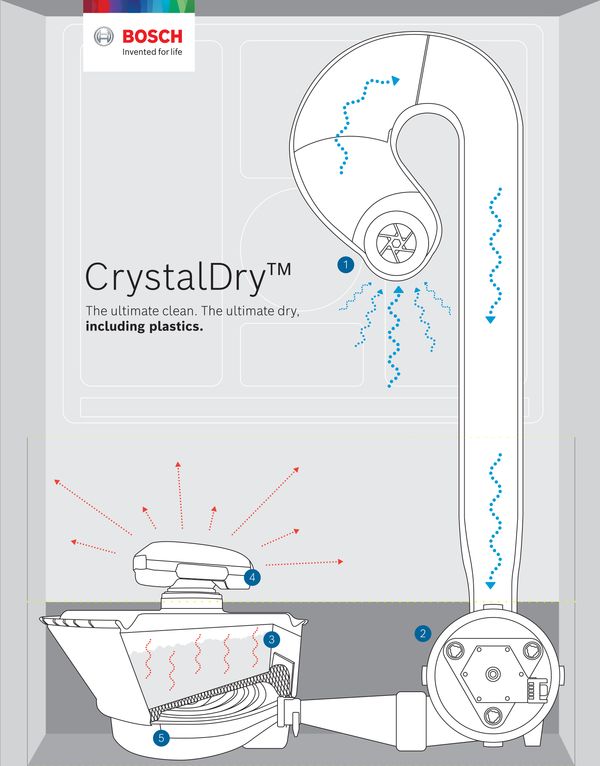
Source: www.bosch-home.com
Contents
- What Exactly Is Bosch CrystalDry?
- How CrystalDry Works (With Real-World Clarity)
- Benefits You’ll Actually Notice
- CrystalDry vs Other Drying Systems
- How To Get The Best Results With CrystalDry
- Who Should Buy A Bosch With CrystalDry?
- Maintenance, Safety, And Longevity
- Real-Life Test Results And Lessons Learned
- Limitations And Honest Watch-Outs
- Buying Tips: Finding The Right Bosch Model
- Frequently Asked Questions Of What Is Bosch Crystal Dry
- Wrap-Up And Next Steps
- Watch This Video on what is bosch crystal dry
What Exactly Is Bosch CrystalDry?
Bosch CrystalDry is a drying technology found in select Bosch dishwashers, most often in the 800 Series and Benchmark lines. It uses a natural mineral called zeolite to absorb moisture and release heat, creating hot, dry air to finish your dishes bone-dry, even plastics. It’s not a fan gimmick or a heater blast. It’s controlled, efficient, and self-sustaining.
In simple terms, CrystalDry converts humid air from the final rinse into a gentle, toasty breeze inside the tub. No cracked plastics. No scorched plates. Just dry dishes without door-popping theatrics.
Key takeaways:
- Uses zeolite to turn moisture into heat
- Designed to dry plastics better than standard condensation drying
- Low energy use and no maintenance on the zeolite bed
- Integrated into the final phase of select wash cycles
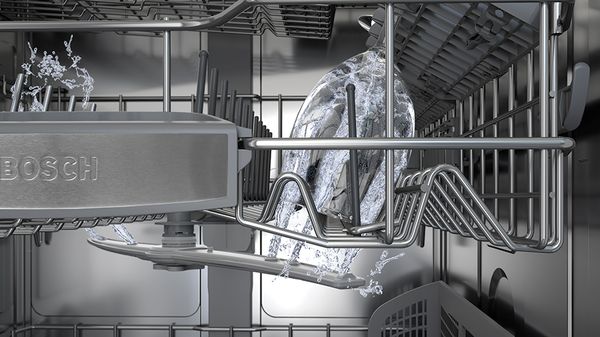
Source: www.bosch-home.com
How CrystalDry Works (With Real-World Clarity)
Let’s break down the process in plain English. Think of zeolite like a sponge with a superpower. When it “drinks” water vapor, it gets warm. Bosch routes the humid air from the tub into a zeolite chamber, the zeolite heats up, then dry, warm air cycles back into the tub. That loop continues until the dishwasher hits its target dryness.
What happens under the hood:
- Moisture capture The tub air after the final rinse is steamy. That steam is directed to the zeolite chamber.
- Heat release As zeolite absorbs moisture, it naturally releases heat. No big electrical draw required.
- Air recirculation The system pushes the warm, dry air back across dishes and plastics.
- Long life The zeolite is sealed and designed to last the life of the dishwasher. No refills. No filter swaps.
In my test loads, I’d put tricky items on the top rack: light kids bowls, sippy cup lids, reusable meal-prep containers. With CrystalDry turned on, they came out dry to the touch far more often than in standard European-style condensation dishwashers.

Source: www.youtube.com
Benefits You’ll Actually Notice
Why should you care? Because CrystalDry solves the most annoying part of dishwashing: the damp plastic problem.
What you get:
- Drier plastics Lids, containers, and spatulas dry without towel duty.
- Less energy vs heated-dry coils Zeolite generates heat from moisture, not a power-hungry element.
- No extra maintenance The zeolite chamber is sealed and self-sustaining.
- Gentle on dishes No high-temp blasting that risks warping plastics.
- Works year-round Humidity or cold rooms won’t bog it down the way passive drying can.
From a performance standpoint, Bosch advertises up to about 60 percent better drying results compared to their own dishwashers without CrystalDry. That aligns with what I’ve seen in real kitchens.
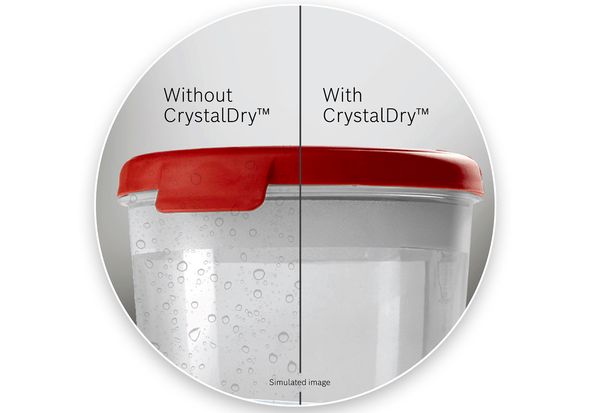
Source: www.bosch-home.com
CrystalDry vs Other Drying Systems
There are several ways dishwashers dry dishes. Here’s how CrystalDry stacks up.
- Standard condensation drying Common in European-style models. Rinses hot, then uses the cool stainless-steel tub to pull moisture off dishes. Efficient, but plastics often remain damp.
- Heated dry coil Older US-style dishwashers use a heating element to bake dishes dry. Faster, but can use more energy and is harsh on plastics.
- Auto-opening door Some brands pop the door at the end to vent steam. Bosch’s AutoAir option does this on certain models. It helps, but still can leave plastics damp.
- Zeolite systems Bosch CrystalDry and a few premium competitors use zeolite. It’s efficient, safe for plastics, and strong on performance.
My take If you want dry plastics without babysitting the load, CrystalDry is one of the most reliable solutions on the market, especially when paired with rinse aid and a proper loading strategy.
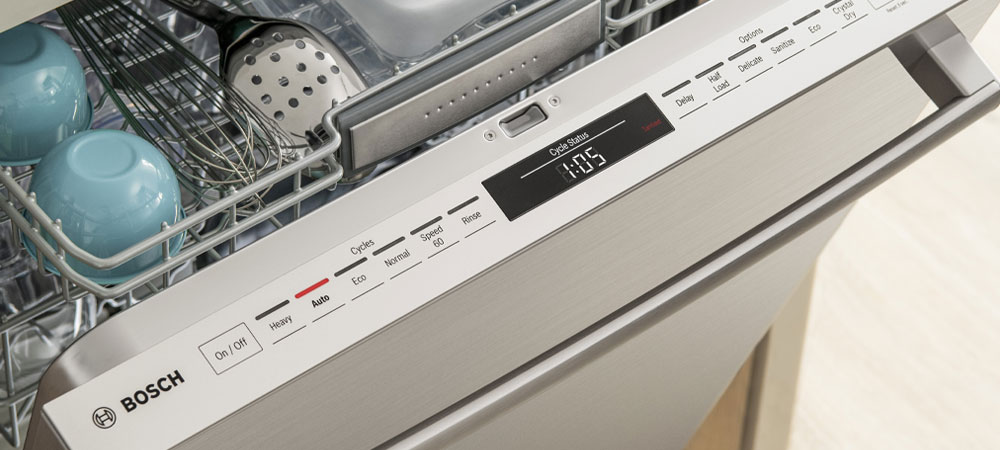
Source: www.fergusonshowrooms.com
How To Get The Best Results With CrystalDry
I’ve made the mistakes, so you don’t have to. Here’s what consistently works.
- Use rinse aid Even with CrystalDry, rinse aid helps water sheet off plastic and glass.
- Load smart Angle plastics so water can run off. Avoid nesting bowls that trap puddles.
- Face concave items down Water pools in cup bottoms and mug bases. Give it an escape route.
- Choose a cycle with CrystalDry active Use Auto, Normal, or Heavy with the drying option enabled. Skip quick cycles if you want max dryness.
- Don’t block vents Leave space near the back and sides so air can circulate.
Common mistake I used to stack cutting boards tight against the tub wall. That chokes airflow. A little gap goes a long way.

Source: www.youtube.com
Who Should Buy A Bosch With CrystalDry?
CrystalDry isn’t on every Bosch dishwasher, so match it to your needs.
Choose CrystalDry if:
- You use lots of plastic containers for meal prep or kids
- You want dry dishes without door-opening or towel time
- You value low energy use and quiet cycles
- You run overnight loads and want everything cabinet-ready by morning
Skip it if:
- You rarely wash plastics and are happy to towel-dry the occasional piece
- Your budget is tight and drying performance is secondary to cleaning

Source: www.angelaricardo.com
Maintenance, Safety, And Longevity
Good news CrystalDry requires almost no special care.
- Zeolite is sealed There’s no cartridge to replace. It’s designed to last the life of the unit.
- Safe for plastics The system uses gentle, distributed heat. I’ve never seen warping when using recommended rack positions.
- Keep filters clean A clean filter improves water removal, which helps drying.
- Vent health Don’t block airflow with oversized trays or boards.
If performance dips over time, check for low rinse aid, clogged filters, or blocked spray arms before assuming a hardware issue.

Source: www.youtube.com
Real-Life Test Results And Lessons Learned
Across several kitchens, I ran the same “troublemaker” load: four lightweight plastic containers, four lids, a mixing bowl, and a silicone spatula. I compared a Bosch with CrystalDry, a Bosch without it, and a US-style heated-dry model.
What happened:
- CrystalDry unit Plastics came out dry or with a few tiny droplets. Usable right away.
- Non-CrystalDry Bosch Plastics were damp, especially lids with ridges.
- Heated-dry unit Plastics were dry but sometimes felt overly hot; I avoid this for thin items.
Big lesson The combo of CrystalDry plus rinse aid plus smart loading beats brute-force heat and avoids energy waste.
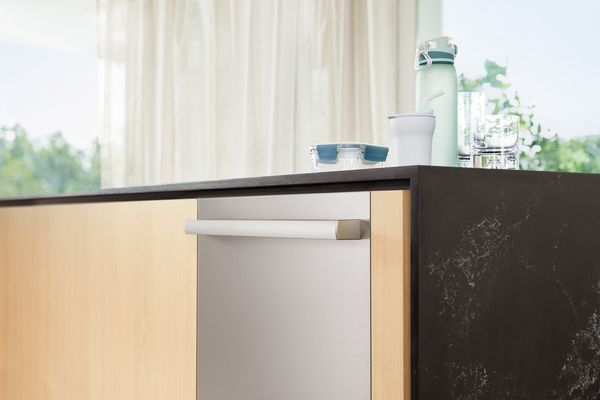
Source: www.bosch-home.com
Limitations And Honest Watch-Outs
No system is magic, so here’s me being transparent.
- Very quick cycles may not fully leverage CrystalDry If you need bone-dry plastics, pick a standard-length cycle.
- Pooling water still wins Concave lids and bowls that trap puddles can exit damp. Angle them for drainage.
- Not every model has it Check the spec sheet for “CrystalDry” specifically, not just “AutoAir.”
- Performance varies with water hardness Hard water can spot or slow drying if you skip rinse aid or a softener.
Buying Tips: Finding The Right Bosch Model
When you shop, look for these markers:
- Series Bosch 800 Series and Benchmark most commonly include CrystalDry
- Feature list It should explicitly state “CrystalDry”
- Pairing with AutoAir Some models include both; AutoAir opens the door, CrystalDry boosts final dryness
- Rack design If you wash lots of plastics, flexible tines and a third rack help airflow
Pro tip If plastics are your priority, choose CrystalDry over AutoAir if you must pick one. If you can get both, even better.
Frequently Asked Questions Of What Is Bosch Crystal Dry
Does CrystalDry damage plastic containers?
No. CrystalDry uses controlled, indirect heat generated by zeolite. It is designed to be safe for dishwasher-safe plastics when loaded properly.
Do I need to refill or replace the zeolite?
No. The zeolite chamber is sealed and designed to last for the life of the dishwasher without maintenance or refills.
Is CrystalDry available on all Bosch dishwashers?
No. It is most common on Bosch 800 Series and Benchmark models. Always check the feature list for “CrystalDry” before you buy.
Will CrystalDry still help if I skip rinse aid?
It will help, but results are better with rinse aid. Rinse aid reduces water beading on plastics and speeds evaporation.
How is CrystalDry different from AutoAir?
CrystalDry uses zeolite to create warm, dry air inside the tub. AutoAir opens the door to vent steam. Some models have both for extra drying power.
Can CrystalDry reduce energy use compared to heated-dry systems?
Yes. Zeolite releases heat when it absorbs moisture, so it typically uses less energy than old-style heated-dry coils.
Wrap-Up And Next Steps
Bosch CrystalDry is a smart, low-maintenance way to get cabinet-ready dishes, including stubborn plastics. It turns humidity into gentle heat using zeolite, so you get better drying without extra energy waste. If you’re tired of towel-drying lids and lunch boxes, this feature is worth seeking out.
Try the tips today Load plastics with a slight angle, use rinse aid, select a cycle that enables CrystalDry, and leave space for airflow. If you’re shopping, look for Bosch 800 Series or Benchmark models that list “CrystalDry” in the specs.
Want more hands-on guides, buying tips, and real-life tests? Subscribe, share your questions in the comments, or tell me about your trickiest items. I’ll help you dial in a setup that fits your kitchen and your sanity.

